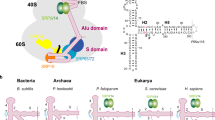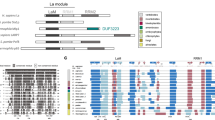Abstract
By sequence-specific binding to 3′ UUU-OH, the La protein shields precursor (pre)-RNAs from 3′ end digestion and is required to protect defective pre–transfer RNAs from decay. Although La is comprised of a La motif and an RNA-recognition motif (RRM), a recent structure indicates that the RRM β-sheet surface is not involved in UUU-OH recognition, raising questions as to its function. Progressively defective suppressor tRNAs in Schizosaccharomyces pombe reveal differential sensitivities to La and Rrp6p, a 3′ exonuclease component of pre-tRNA decay. 3′ end protection is compromised by mutations to the La motif but not the RRM surface. The most defective pre-tRNAs require a second activity of La, in addition to 3′ protection, that requires an intact RRM surface. The two activities of La in tRNA maturation map to its two conserved RNA-binding surfaces and suggest a modular model that has implications for its other ligands.
This is a preview of subscription content, access via your institution
Access options
Subscribe to this journal
Receive 12 print issues and online access
$189.00 per year
only $15.75 per issue
Buy this article
- Purchase on Springer Link
- Instant access to full article PDF
Prices may be subject to local taxes which are calculated during checkout






Similar content being viewed by others
References
Maraia, R.J. & Bayfield, M.A. The La protein-RNA complex surfaces. Mol. Cell 21, 149–152 (2006).
Maraia, R.J. & Intine, R.V. Recognition of nascent RNA by the human La antigen: conserved and diverged features of structure and function. Mol. Cell. Biol. 21, 367–379 (2001).
Wolin, S.L. & Cedervall, T. The La protein. Annu. Rev. Biochem. 71, 375–403 (2002).
Hopper, A.K. & Phizicky, E.M. tRNA transfers to the limelight. Genes Dev. 17, 162–180 (2003).
Pannone, B., Xue, D. & Wolin, S.L. A role for the yeast La protein in U6 snRNP assembly: evidence that the La protein is a molecular chaperone for RNA polymerase III transcripts. EMBO J. 17, 7442–7453 (1998).
Intine, R.V., Tenenbaum, S.A., Sakulich, A.S., Keene, J.D. & Maraia, R.J. Differential phosphorylation and subcellular localization of La RNPs associated with precursor tRNAs and translation-related mRNAs. Mol. Cell 12, 1301–1307 (2003).
Inada, M. & Guthrie, C. Identification of Lhp1p-associated RNAs by microarray analysis in Saccharomyces cerevisiae reveals association with coding and noncoding RNAs. Proc. Natl. Acad. Sci. USA 101, 434–439 (2004).
Holcik, M. & Sonenberg, N. Translational control in stress and apoptosis. Nat. Rev. Mol. Cell Biol. 6, 318–327 (2005).
Belisova, A. et al. RNA chaperone activity of protein components of human Ro RNPs. RNA 11, 1084–1094 (2005).
Chakshusmathi, G., Kim, S.D., Rubinson, D.A. & Wolin, S.L. A La protein requirement for efficient pre-tRNA folding. EMBO J. 22, 6562–6572 (2003).
Yoo, C.J. & Wolin, S.L. The yeast La protein is required for the 3′ endonucleolytic cleavage that matures tRNA precursors. Cell 89, 393–402 (1997).
Johansson, M.J. & Bystrom, A.S. Dual function of the tRNA(m(5)U54)methyltransferase in tRNA maturation. RNA 8, 324–335 (2002).
Anderson, J. et al. The essential Gcd10p-Gcd14p nuclear complex is required for 1-methyladenosine modification and maturation of initiator methionyl-tRNA. Genes Dev. 12, 3650–3662 (1998).
Kadaba, S. et al. Nuclear surveillance and degradation of hypomodified initiator tRNAMet in S. cerevisiae. Genes Dev. 18, 1227–1240 (2004).
LaCava, J. et al. RNA degradation by the exosome is promoted by a nuclear polyadenylation complex. Cell 121, 713–724 (2005).
Vanacova, S. et al. A new yeast poly(A) polymerase complex involved in RNA quality control. PLoS Biol. 3, e189 (2005).
Anderson, J.T. RNA turnover: unexpected consequences of being tailed. Curr. Biol. 15, R635–R638 (2005).
Kadaba, S., Wang, X. & Anderson, J.T. Nuclear RNA surveillance in Saccharomyces cerevisiae: Trf4p-dependent polyadenylation of nascent hypomethylated tRNA and an aberrant form of 5S rRNA. RNA 12, 508–521 (2006).
Alexandrov, A. et al. Rapid tRNA decay can result from lack of nonessential modifications. Mol. Cell 21, 87–96 (2006).
Engelke, D.R. & Hopper, A.K. Modified view of tRNA: stability amid sequence diversity. Mol. Cell 21, 144–145 (2006).
Teplova, M. et al. Structural basis for recognition and sequestration of UUU-OH 3′-termini of nascent RNA pol III transcripts by La, a rheumatic disease autoantigen. Mol. Cell 21, 75–85 (2006).
Alfano, C. et al. Structural analysis of cooperative RNA binding by the La motif and central RRM domain of human La protein. Nat. Struct. Mol. Biol. 11, 323–329 (2004).
Maris, C., Dominguez, C. & Allain, F.H. The RNA recognition motif, a plastic RNA-binding platform to regulate post-transcriptional gene expression. FEBS J. 272, 2118–2131 (2005).
Hamada, M., Sakulich, A.L., Koduru, S.B. & Maraia, R. Transcription termination by RNA polymerase III in fission yeast. A genetic and biochemical model system. J. Biol. Chem. 275, 29076–29081 (2000).
Intine, R.V. et al. Transfer RNA maturation is controlled by phosphorylation of the human La antigen on serine 366. Mol. Cell 6, 339–348 (2000).
Intine, R.V., Dundr, M., Misteli, T. & Maraia, R.J. Aberrant nuclear trafficking of La protein leads to disordered processing of associated precursor tRNAs. Mol. Cell 9, 1113–1123 (2002).
Huang, Y., Intine, R.V., Mozlin, A., Hasson, S. & Maraia, R.J. Mutations in the RNA polymerase III subunit Rpc11p that decrease RNA 3′ cleavage activity increase 3′-terminal oligo(U) length and La-dependent tRNA processing. Mol. Cell. Biol. 25, 621–636 (2005).
Briggs, M.W., Burkard, K.T. & Butler, J.S. Rrp6p, the yeast homologue of the human PM-Scl 100-kDa autoantigen, is essential for efficient 5.8 S rRNA 3′ end formation. J. Biol. Chem. 273, 13255–13263 (1998).
Allmang, C. et al. Functions of the exosome in rRNA, snoRNA and snRNA synthesis. EMBO J. 18, 5399–5410 (1999).
van Hoof, A., Lennertz, P. & Parker, R. Yeast exosome mutants accumulate 3′-extended polyadenylated forms of U4 small nuclear RNA and small nucleolar RNAs. Mol. Cell. Biol. 20, 441–452 (2000).
Dong, G., Chakshusmathi, G., Wolin, S.L. & Reinisch, K.M. Structure of the La motif: a winged helix domain mediates RNA binding via a conserved aromatic patch. EMBO J. 23, 1000–1007 (2004).
Goodier, J.L., Fan, H. & Maraia, R.J. A carboxy-terminal basic region controls RNA polymerase III transcription factor activity of human La protein. Mol. Cell. Biol. 17, 5823–5832 (1997).
Fan, H., Goodier, J.L., Chamberlain, J., Engelke, D.R. & Maraia, R.J. 5′ Processing of tRNA precursors can be modulated by the human La antigen phosphoprotein. Mol. Cell. Biol. 18, 3201–3211 (1998).
Van Horn, D.J., Yoo, C.J., Xue, D., Shi, H. & Wolin, S.L. The La protein in Schizosaccharomyces pombe: a conserved yet dispensable phosphoprotein that functions in tRNA maturation. RNA 3, 1434–1443 (1997).
O'Connor, J.P. & Peebles, C.L. In vivo pre-tRNA processing in Saccharomyces cerevisiae. Mol. Cell. Biol. 11, 425–439 (1991).
Kenan, D.J. & Keene, J.D. La gets its wings. Nat. Struct. Mol. Biol. 11, 303–305 (2004).
Rothstein, R.J. One-step gene disruption in yeast. Methods Enzymol. 101, 202–211 (1983).
Ohi, R., Feoktistova, A. & Gould, K.L. Construction of vectors and a genomic library for use with his3-deficient strains of Schizosaccharomyces pombe. Gene 174, 315–318 (1996).
Wach, A., Brachat, A., Pohlmann, R. & Philippsen, P. New heterologous modules for classical or PCR-based gene disruptions in Saccharomyces cerevisiae. Yeast 10, 1793–1808 (1994).
Forsburg, S.L. Comparison of Schizosaccharomyces pombe expression systems. Nucleic Acids Res. 21, 2955–2956 (1993).
Driscoll, C.T., Darlington, G.J. & Maraia, R.J. The conserved 7SK snRNA gene localizes to human chromosome 6 by homolog exclusion probing of somatic cell hybrid RNA. Nucleic Acids Res. 22, 722–725 (1994).
Trotta, C.R. & Abelson, J. tRNA splicing: an RNA world add-on or an ancient reaction?. in The RNA World 2nd edn (eds. Gesteland, R.F., Cech, T.R. & Atkins, J.F.) 561–584 (Cold Spring Harbor Laboratory Press, Cold Spring Harbor, New York, USA, 1999).
Acknowledgements
We thank M. Blum for media preparation, S. Hasson (University of California at Los Angeles) for tRNAUGASer(U47:6), D. Patel for providing coordinates before publication and J. Anderson for advice, as well as S. Wolin, The Friday Seminar, R. Crouch and members of the Laboratory of Molecular Growth Regulation for discussion, comments or both, and A. Hinnebusch for suggesting the hypomorph and for comments on the manuscript. This work was supported by the Intramural Research Program of the National Institute of Child Health and Human Development, US National Institutes of Health. R.J.M. serves as an Officer in the US Public Health Service.
Author information
Authors and Affiliations
Contributions
Y.H., M.A.B. and R.V.I. designed and performed experiments. R.J.M. designed experiments and wrote the manuscript
Corresponding author
Ethics declarations
Competing interests
The authors declare no competing financial interests.
Rights and permissions
About this article
Cite this article
Huang, Y., Bayfield, M., Intine, R. et al. Separate RNA-binding surfaces on the multifunctional La protein mediate distinguishable activities in tRNA maturation. Nat Struct Mol Biol 13, 611–618 (2006). https://doi.org/10.1038/nsmb1110
Received:
Accepted:
Published:
Issue Date:
DOI: https://doi.org/10.1038/nsmb1110
This article is cited by
-
Altered tRNA processing is linked to a distinct and unusual La protein in Tetrahymena thermophila
Nature Communications (2022)
-
Mechanism of RNA polymerase III termination-associated reinitiation-recycling conferred by the essential function of the N terminal-and-linker domain of the C11 subunit
Nature Communications (2021)
-
The nuclear RNA polymerase II surveillance system targets polymerase III transcripts
The EMBO Journal (2011)
-
Precursor-product discrimination by La protein during tRNA metabolism
Nature Structural & Molecular Biology (2009)
-
Distinct roles of HDAC complexes in promoter silencing, antisense suppression and DNA damage protection
Nature Structural & Molecular Biology (2007)



